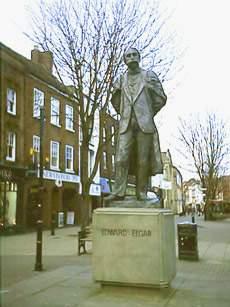
Sir Edward Elgar (1857-1934)
Marina Duffell

A true son of Worcestershire, Sir Edward Elgar must be considered one of the county’s most prominent figures in recent history, his life spanning the reigns of three monarchs, Queen Victoria, Edward VII and George V.
 Son of a Worcester music dealer, he was very sensitive to rejection by a society whose acceptance he desperately needed to succeed. Playing the violin alongside his father in Worcester Cathedral started a lifelong involvement for the young Elgar with the Three Choirs Festival.
Son of a Worcester music dealer, he was very sensitive to rejection by a society whose acceptance he desperately needed to succeed. Playing the violin alongside his father in Worcester Cathedral started a lifelong involvement for the young Elgar with the Three Choirs Festival.
On his marriage to Caroline Alice, daughter of Major General Sir Henry Gee Roberts, Elgar reluctantly moved to London. Although this was essential to the success of an up-and-coming composer, he was never happy in the metropolis, and could not wait to return to his beloved Worcestershire countryside.
Recognition came eventually with the acceptance by Queen Victoria of pieces written for her Diamond Jubilee, and a knighthood followed in 1904 when Edward VII expressed enjoyment of the first of the Enigma Variations”. The general public sang Elgar’s “Land of Hope and Glory” enthusiastically, but his more serious compositions were largely ignored. Ironically his “Dream of Gerontius” was appreciated more in pre-war Germany than it ever was in England.
A melancholy, insecure man at the best of times, Elgar could foresee in the outbreak of World War I the destruction of his rural idyll in the Heart of England. The sadness in his “Cello Concerto” and “Second Symphony” reflects his personal sense of loss and the passing of his beloved Edward VII, but he was better known for his “Coronation March” later commissioned by Geroge V.
Little more was written before his death, but his genius was recognized by George Bernard Shaw who wrote “Elgar is carrying on Beethoven’s business”.
The Elgar Statue was created by Kenneth Potts, and stands facing the Cathedral at the end of Worcester High Street.
Copyright © 2000
Marina Duffell

Can you create more words or pictures for this or another page? You don't have to be an expert. Borrow a book from the library to get the basics of your subject , but write in your own words and add a little something to make it special. 100-300 words would be enough for your first piece: this short note is more than 100. You can always add more later! Any photo you took or has been in your family for years is a possibility. Is there something distinctively local about it - not necessarily the place, but perhaps the people, what they are wearing or doing? Send it by email to whe@freeuk.com, or by post to Worcester Writers' Circle c/o Worcester Library, Foregate Street, Worcester WR1 1DT.
Lower Broadheath
Worcestershire History Encyclopaedia
 Son of a Worcester music dealer, he was very sensitive to rejection by a society whose acceptance he desperately needed to succeed. Playing the violin alongside his father in Worcester Cathedral started a lifelong involvement for the young Elgar with the Three Choirs Festival.
Son of a Worcester music dealer, he was very sensitive to rejection by a society whose acceptance he desperately needed to succeed. Playing the violin alongside his father in Worcester Cathedral started a lifelong involvement for the young Elgar with the Three Choirs Festival.
